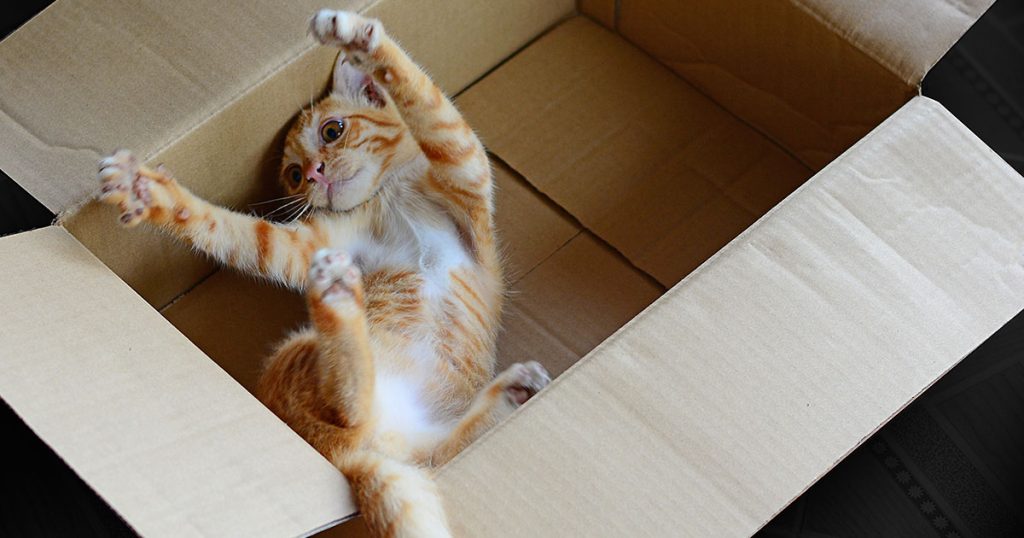Many cats don’t respond well to transport boxes. Here you can find out how you can make things easier for your four-legged friends.
Table of Contents
1. Choosing the right transport box
There are a wide variety of cat carriers available in stores, from classic hard-shell boxes and woven basket caves to stylish carrier bags. For cats who are equally reluctant to go in and out of a box, you should definitely avoid models that only have one door opening.
In general, multi-part hard-shell boxes where the lid can be completely removed are best. With them you can simply lift your cat out without any stress . These plastic boxes for kitten are also super easy to clean in an emergency.

2. Integrate the transport box into your furniture landscape
But what use is the best transport box if your cat doesn’t know the item and trusts it even less? Most of us most likely store the transport box in the far corner of the basement and then pull it out ten minutes before departure only to be surprised that our four-legged friend has no desire for the unknown item.
Instead, the transport box should be part of your furniture and accessible to get your cat at all times. Therefore, place it next to the sofa or perhaps in the play area so that your cat can familiarize itself with the box.
3. Make the transport box a land of milk and honey
The transport box shouldn’t just be a boring box in which you can be carted to the vet in the worst case scenario. Instead, make the box interesting and exciting for the four-legged friends . Put in your favorite cozy blanket or a T-shirt you wear; Familiar smells reduce stress and make the box less frightening for your cat.
Turn the box into a play and snack area: Integrate the box into the play sessions by placing balls and play fishing rods in it to lure the cat in. Every time your cat approaches the box or even dares to go in, reward it with a treat and petting.
4. The trick for particularly suspicious cats
However, some feline are not so easily convinced by transport boxes. In these cases you just need a little more patience. If you have a multi-part hard-shell box, simply take it apart and familiarize your cat with only the base part without the lid. The box looks more like a bed in which your four-legged friend can sleep, play and eat. Then insert the lid without the door and so on.

5. Next steps
As soon as your cat doesn’t panic at the sight of the box, maybe even takes an afternoon nap in it and eats snacks in the box, you can take the next steps. It is important that you continually encourage your cat to go into the box.
-
- If she goes in voluntarily, you can try closing the door. At the beginning only very briefly, over time it gets longer and longer.
-
- Maybe you walk around the apartment with the cat in the box and then let it out again. Don’t forget to always reward your cat with petting and treats so that he or she associates the box with positive experiences.
Always remember that every cat is different: one cat may no longer have any problems with the transport box after a week, while another may need several weeks to get used to it. So stay patient, always reward progress and give your cat enough time.
FAQs
Q: How can I get my cat used to being in a carrier?
A: You can start by making the carrier a positive and familiar space for your cat. Leave the carrier out in the open with the door open so your cat can explore and get comfortable with it. You can also encourage them to go inside the carrier by placing treats or their favorite toys inside.
Q: What are some tips for training my cat to stay calm during car rides?
A: To help your cat stay calm during car rides, you can start by taking them on short, positive car trips to create a positive association with being in the carrier and traveling. You can also use pheromone sprays like Feliway to help reduce your cat’s stress during car rides.
Q: How do I acclimate my cat to the crate for veterinarian visits?
A: Acclimating your cat to the crate for vet visits involves creating a positive association with the carrier. You can do this by leaving the carrier out in the open and introducing treats or catnip inside to encourage your cat to explore and become comfortable with it.
Q: What are some ways to make vet visits less stressful for my cat?
A: You can make vet visits less stressful for your cat by creating a calm and familiar environment inside the carrier. Use a soft blanket or bedding, and consider using pheromone sprays or treats to help your cat feel more at ease during the visit.
Q: How can I train my kitten to feel comfortable in a carrier?
A: Training your kitten to feel comfortable in a carrier involves positive reinforcement and gradual exposure to the carrier. Start by leaving the carrier out in the open and offering treats and toys inside to encourage your kitten to explore and associate the carrier with positive experiences.
Q: What are some steps I can take to get my older cat used to being in a carrier?
A: For older cats, it may take more time and patience to acclimate them to the carrier. You can start by using positive reinforcement, creating a comfortable environment inside the carrier, and gradually increasing their exposure to the carrier to help them feel more at ease.
Q: How can I encourage my cat to leave the carrier at the vet’s office?
A: You can encourage your cat to leave the carrier at the vet’s office by creating a calm and inviting space for them in the examination room. Use treats or toys to entice them out of the carrier and create a positive association with the vet’s office environment.
Q: What should I do if my cat is afraid of getting into a carrier?
A: If your cat is afraid of getting into a carrier, you can try using positive reinforcement and gradual exposure to the carrier to help them overcome their fear. Use treats, toys, and comforting items inside the carrier to make it a more inviting space for your cat.
Q: Are there any specific training techniques I can use to help my cat overcome their fear of the carrier?
A: Yes, you can use crate training techniques to help your cat overcome their fear of the carrier. This involves gradual exposure, positive reinforcement, and creating a comfortable and familiar environment inside the carrier to help your cat feel more at ease.
Q: What can I do to keep my cat calm and relaxed when using a carrier?
A: To keep your cat calm and relaxed when using a carrier, you can create a comfortable and familiar environment inside the carrier. Use soft bedding, familiar scents, and soothing pheromones to help your cat feel more at ease during travel or vet visits.